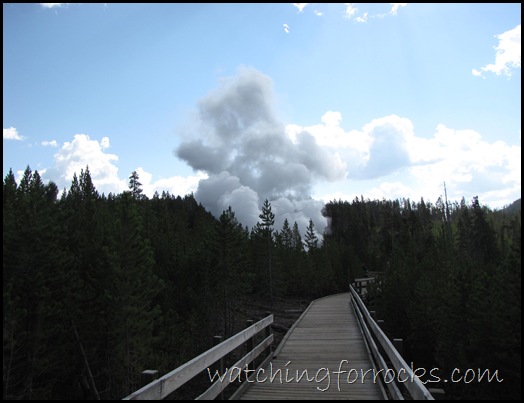One day last week the most amazing thing occurred in Yellowstone. A geyser erupted. This wasn’t just any old geyser, even though these things are blowing off water and steam all the time around here. It’s what Yellowstone is famous for. Only about a half dozen are predictable, and of these only Old Faithful reaches heights of up to 120 feet. Rain or shine, night and day, predictable Old Faithful goes off about every 90 minutes.
 |
| Steamboat Geyser in steam phase, August 2, 2013 |
The unpredictable eruption of water and steam that reached heights of up to 300 feet last week occurred in the Norris geyser basin at Steamboat Geyser, the tallest and most physically active thermal feature in the world. Its eruptions are not predictable by any means – the last time Steamboat erupted was in 2005. Everyone in Yellowstone, from visitor to staff, hopes they will be there when it blows, but this past Wednesday, July 31 at 7:30 in the evening, only a few people were very, very lucky to have witnessed it. Sadly I was not one of those. I didn’t even hear about it until the next morning.
According to some accounts, prior to 1878 there was no hot spring here at all (or if there was it was small) and it was this year that saw the first of Steamboat’s major eruptions. And how did anyone know it had erupted, if no one witnessed it and there was no high–tech monitoring equipment nearby? Clues were found in nearby trees that were killed, huge rocks that had expelled from the crater, and everything else being covered with sand and mud from run–off channels which were the result a huge eruption that was most likely over 100 feet high.
Over the next decades eruptions were considered minor (perhaps 30 feet or so?) but there were major ones, too, of over 100 feet. In 1911 Steamboat erupted to a height held to be over 250 feet, but then it remained quiet with only minor activity for almost exactly 50 years. But then, between 1961 and 1969 there were 90 major eruptions, with 29 occurring in 1964 alone. Impressive, no doubt!
Several times over the years the water column has been measured to be at about 380 feet, more than three times the height of Old Faithful, with none less than 250 feet high.
 |
| September 2012 – there is little action at Steamboat Geyser |
 |
| August 2013 – Thirty six hours after Steamboat’s major eruption, the steam phase continues |
A geyser has two distinct phases – a water phase and a steam phase – and last week Steamboat’s water phase lasted around nine minutes, which is typical for one of its major eruptions. The roar of the initial explosion of the water must have been tremendous, followed by countless hundred thousand gallons of water being discharged hundreds of feet into the air.
The steam phase can last up to 48 hours, and so although I was not lucky enough to witness the actual water phase of Steamboat I still felt compelled to go over there on my first day off. Thirty six hours after the initial eruption steam continued to billow violently from the vent of the geyser. I was definitely impressed.
Nearby Cistern Spring has an interesting link to all this activity. It is the only known thermal feature to be connected to Steamboat by an underground network of channels and to be affected by any of its eruptions. During every major eruption of Steamboat, Cistern typically drains and then refills several days later. And that is exactly what it did this time.
 |
| Cistern Spring, September 2012 |
 |
| Cistern Spring 36 hours after the eruption of Steamboat Geyser |
It’s said that Steamboat Geyser could erupt again every four days or so for a while after a major eruption. It could also be another fifty years before its underground reservoir fills again. I don’t know if I’ll be around for either event, but someone most likely will, and they will be very, very lucky indeed.
My reference for the history of Steamboat Geyser was taken from “The Geysers of Yellowstone, 4th ed.” By T. Scott Bryan.






